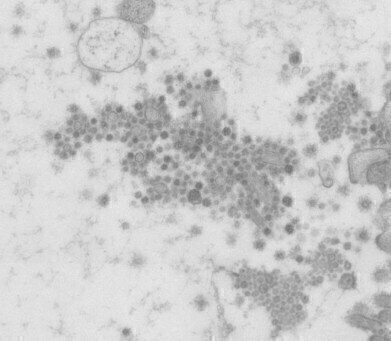News & Views
Images Advance Understanding of SARS-CoV-2 Gut Infection Activity
May 15 2020
Some of the largest and highest resolution images recorded of the SARS-CoV-2 virus, the cause of the Covid-19 pandemic, have been published online by scientists at the University of Dundee and the EMBL’s European Bioinformatics Institute (EMBL-EBI).
Ultra-powerful EM images collected by a consortium of researchers from the Hubrecht Institute in Utrecht, Erasmus MC University Medical Center Rotterdam and Maastricht University in the Netherlands, show the formation of SARS-CoV-2 particles in a tissue model of the human gut, a potentially significant breakthrough in understanding how the disease can infect the intestine.
Each of the images is greater than 30-50 GBytes – which is 500 to 1000 times larger than an image recorded on an iPhone-- and the scientists who collected them were only able to include very small parts of the images in their paper(1).
To share these massive chunks of unique data, the Dutch team turned to a group of computer scientists at the University of Dundee's School of Life Sciences, led by Professor Jason Swedlow, who have built and run the Image Data Resource (IDR), a publication system for very large, complex images recorded using the world's most powerful microscopes and imaging systems. Two datasets available in the IDR which show the virus assembling and leaving the human intestinal cells.
The data files generated by Maastricht University scientists showing SARS-CoV-2 locations in the model of the human gut are also being deposited in the EMBL-EBI’s EMPIAR archive for wider distribution to the biomedical community. Scientists can download the original data and re-analyse them using their own tools and methods.
Professor Swedlow said, “We're excited to publish these important new datasets in IDR, where they can be seen by researchers around the world, who can also scan the images and view the SARS-CoV-2 virus up close on their computer.We have included annotations from the authors so anyone who reads the paper from the research teams in the Netherlands can easily see what the authors published, but also can examine other parts of the data and maybe make their own discoveries.
“This kind of sharing of data has never been more important than in our current situation where we urgently need to work together around the world to find out more about this disease and ultimately be able to treat or control it.”
The IDR run by Professor Swedlow in collaboration with Dr Alvis Brazma and Dr Ugis Sarkans at EMBL's European Bioinformatics Institute, has published over 170 TBytes of highly valuable imaging data from over 70 studies.
IDR was built and is run through funding from the UKRI's Biotechnology and Biological Sciences Research Council and the Wellcome Trust. EMPIAR was built and is run through funding from UKRI’s Medical Research Council and the Wellcome Trust. IDR and EMPIAR are part of an ecosystem of imaging resources being constructed by EMBL-EBI that includes its recently announced BioImage Archive, funded through UKRI’s Strategic Priority Fund.
(1) Publication SARS-CoV-2 productively Infects Human Gut Enterocytes Mart M. Lamers*, Joep Beumer*, Jelte van der Vaart*, Kèvin Knoops, Jens Puschhof, Tim I. Breugem, Raimond B.G. Ravelli, J. Paul van Schayck, Anna Z. Mykytyn, Hans Q. Duimel, Elly van Donselaar, Samra Riesebosch, Helma J.H. Kuijpers, Debby Schipper, Willine J. van de Wetering, Miranda de Graaf, Marion Koopmans, Edwin Cuppen, Peter J. Peters, Bart L. Haagmans† and Hans Clevers†. Science 2020. * Equal contribution, † equal contribution.
The microscopy data are publicly available via the Image Data Resource (idr0083) and the EMPIAR Archive (10404) - with help from the University of Dundee and the European Bioinformatics Institute) and the genomic data are publicly available via the Gene Expression Omnibus (GSE149312) to ensure efficient sharing of data related to COVID-19 between researchers all across the world.
Digital Edition
Lab Asia 31.2 April 2024
April 2024
In This Edition Chromatography Articles - Approaches to troubleshooting an SPE method for the analysis of oligonucleotides (pt i) - High-precision liquid flow processes demand full fluidic c...
View all digital editions
Events
Apr 28 2024 Montreal, Quebec, Canada
May 05 2024 Seville, Spain
InformEx Zone at CPhl North America
May 07 2024 Pennsylvania, PA, USA
May 14 2024 Oklahoma City, OK, USA
May 15 2024 Birmingham, UK


















